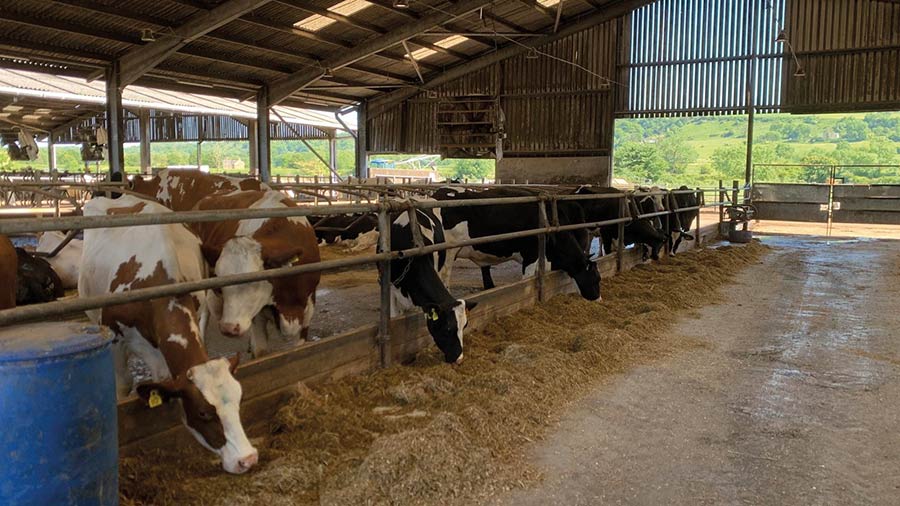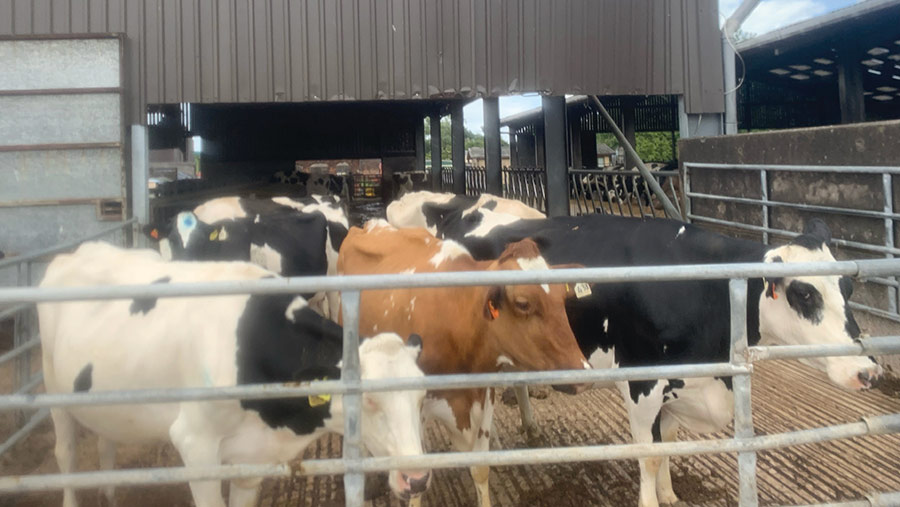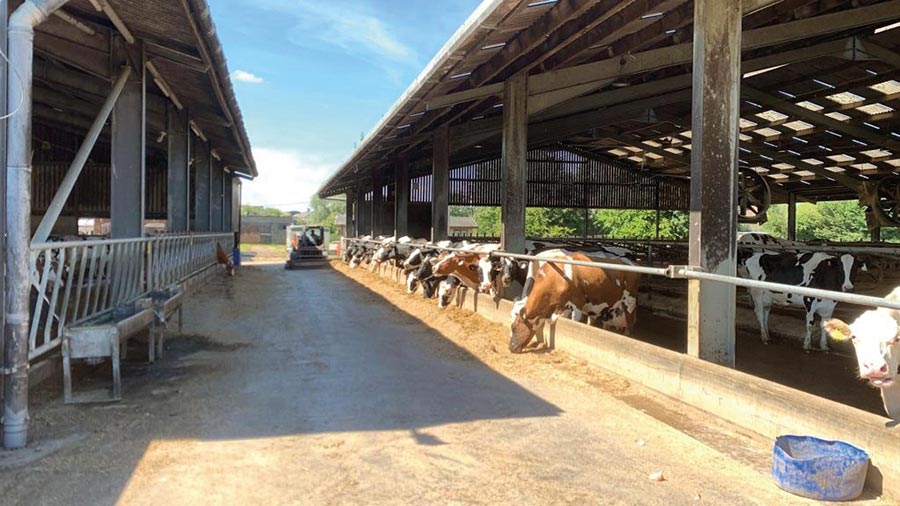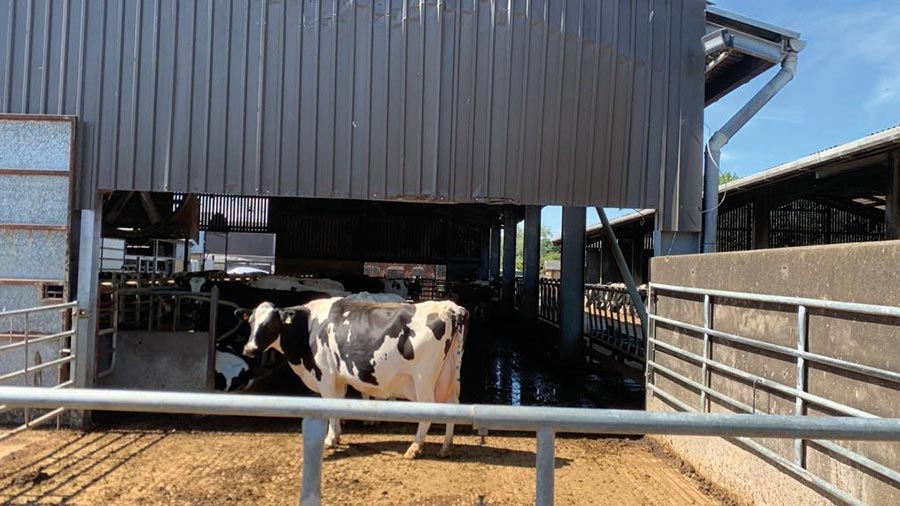Why extra cow space is priority in dairy housing redesign
 © Gary Dalton
© Gary Dalton
The concept of living space for cows is a relatively new one. But for Gary Dalton, it has long been a fundamental part of his strategy for the 370-head Holstein herd at Bushton Farm, near Wootton Bassett.
“This is a Wiltshire County Council farm, and when we came here 23 years ago, we had a vet, called Peter May, out to do some fertility work, and he got chatting about the importance of giving cows space to ensure they express natural behaviour,” explains Mr Dalton.
This sparked a complete rethink of the design of the farm’s buildings and cow areas, with a refurbishment that started about 15 years ago. “At the time, we had old kennel-style cubicles, so with the help from the council we decided to put up some new buildings to provide more space for the cows.”
See also: Better way of measuring reveals ideal dairy cow living space
Today, Mr Dalton provides more space for his herd in two ways when housed – by increased living space and loafing areas.
The emphasis on space at the farm is so great that Mr Dalton has recently come out on top in a survey on living space carried out by his milk buyer.
While the average living space, according to the survey, is about 4.5sq m a cow, at Bushton Farm it is 11.5sq m a cow.
Farm facts
Bushton Farm, Royal Wootton Bassett, Wiltshire
- 370 Holstein cows (some cross-bred)
- Wiltshire County Council
- Average yield – 11,500 litres
- Grazed six months a year. Housed and fed a TMR in the winter
- Calving index 390 days
Living space

© Gary Dalton
Living space refers to the additional space provided to cows above the minimum requirement and includes design features such as wider passageways.
Red Tractor requires a minimum space allowance of 6.5sq m a cow for dairy cows weighing 600-699kg.
The cubicle housing at Bushton Farm features 4.5m passageways. “I had seen some buildings that had 6m passages between cubicles, but this was not something we could afford, so 4.5m was a good compromise.
“We also ensure there is always good lunging space, and cubicles are 2.7m long, rather than the more traditional 2.4m.”
In the fresh cow house, there is a 1.08m feed space allowance for each cow – compared with AHDB recommendations of at least 0.7m of feed space for Holstein-Friesian cows.
AHDB also says that many top-performing herds are offering feed space closer to 1m a cow.
Underpinning the increased living space is a conscious decision to always allow circular movement within the buildings – something that had never been prioritised on farm before.
“This means there are no dead ends at any point in the shed, and the cow has the opportunity to turn left or right at all times.”
He also received some training through the George Vet Group on encouraging circular movement and the benefits this has on cow welfare.
“It is particularly beneficial when there are more dominant cows in the herd that could restrict the movement of younger, smaller cows. If the boss cow stops [a younger cow] turning right, for example, then this gives her the option to go left.
“Space is not everything – nutrition and cow health are vital too. But if you have got all the basics right apart from allowing adequate space, then I don’t believe a cow will do as well.”
Loafing space

© Gary Dalton
As the name suggests, loafing space refers to areas other than passageways and those used for feeding or lying, which cows can access at any time.
This is a feature at Bushton Farm and providing cows with this outdoor loafing space has been fundamental in boosting total cow space, explains Mr Dalton.
“All cows have an open area of concrete, which really increases our overall space provided to each cow,” he says.
There are two cubicle houses – one with 130 beds and the other with 160. These have loafing areas of 25x6m and 30x10m, respectively.
There is an open area between the buildings to provide a further 20x8m pad for loafing.
“I think it is really important from a cow welfare perspective – if she wants to have a bit of ‘me’ time, she can. Quite often in the evening, even in the winter, we will see 10-15 cows just stood out there gazing.
“It’s not because they’ve got nowhere to sleep or lie down, but simply because that’s what they naturally want to do.”

© Gary Dalton
Benefits
While the measurable benefits of increased space have been highlighted in recent studies (see “Research recap”), Mr Dalton says that quantifying the impact on an individual farm basis is trickier.
However, he adds this is an area he and his milk buyer are interested in looking into in the future.
Something tangible he has noticed, however, is a reduction in environmental mastitis cases, which he believes is down to better housing for the cows. “We only have about five cases a year,” he says.
“We also didn’t have a single displaced abomasum for three years – again, something I think has been aided by having more space.”
While an external company does all his breeding work, Mr Dalton adds that having more space also means a greater chance of expression of bulling activity, which simplifies heat detection.
“Whenever anyone visits the farm, they always comment on how quiet and relaxed cows are, and I put this down to them not feeling boxed in and having the freedom to go where they like.”
His advice for others is simple. “Don’t inhibit a cow’s ability to express her potential by restricting her freedom to move.”
Gary Dalton’s tips for creating cow space
- Always allow circular movement in buildings. It is worth taking cubicles out if needs be
- Inside the shed, focus on expanding passageways, feed faces and cubicles to increase space allowance
- Outside, consider giving cattle loafing areas. This can be as simple as a concrete pad. The key is giving them the ability freedom to roam as they please
- Remember, space is not everything. Do not overlook the importance of cow health and nutrition when trying to target overall improved health and wellbeing

© Gary Dalton
Research recap
The benefits of providing cows with more “living space” was highlighted in a recent trial carried out by Jake Thomson at the University of Nottingham, in research funded by AHDB.
For the study, living space was defined as excess space above a baseline – taking into account the number of cows in a group, indoor and outdoor space, and cubicle numbers, width and length.
Cows were split into two groups, with one group receiving 3sq m of living space (9sq m total space) and the other had 6.5sq m of living space (14sq m total space).
A positive effect was seen where cows were given more space. Headline results were:
- 100-600 litres yield increase
- A one-hour increase in lying time a day
- 10-minute increase in feed access a day
